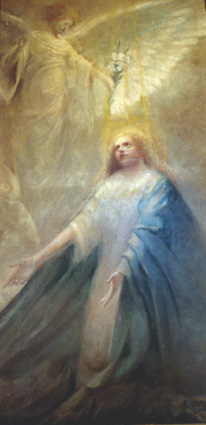 Jan De Cooman painted four stations of the cross. They are pieces of art that are worth viewing.
Jan De Cooman painted four stations of the cross. They are pieces of art that are worth viewing.
First of all, it is important to note that his “Stations of the Cross” are not the result of unrestrained creativity. They are not free creations. They are painted by an order, in which they were required to present the different stations of the cross as a colorful explanation of the evangelical narrative and as a comprehensible story. So the painter stood at each one of the fourteen stations before the problem to present the theme as an emotional, living event.
The official and artistic responsibility and the duality shows in Jan De Cooman’s Stations of the Cross. We see how in some stations the materialism, the declamatory gesture prevails while other stations are showing a very delicate spiritual stress. In some the compositional ability only means craftsmanship. In the other, the line and color are moved on the breath of true inspiration.
About the Stations of the Cross of Jan De Cooman in his native town Zandbergen, the flemish writer Jef CRICK wrote at that time:
The bold, free note is completely absent in these Stations of the Cross, and yet one does not get an impression of skepticism or hoppiness here. Jan was most inspired by the picturesque evangelical story of H.G. in composing these Stations of the Cross (which was finished in an amazingly short space of time). Can. Coppens. In these Stations of the Cross, tradition prevails over the whole line, and theatrical pathos in the gesture of the figurants and in the tragic color of the skies also shimmer, which can already be partially defended, if one learns that this work is destined for a Renaissance church. In these Stations of the Cross a crumbly drawing (which is already a small achievement) sticks to a well-maintained composition and also to a prize for homogeneity. The painter did not want to evade the technical difficulties here and he apparently did not feel the urge for simplicity because he could express everything so easily and cumbersome with his smooth brush stroke. A mature art vision will then, lead over time to the creation of a more sober representation. In the meantime, there is a respectable dose of pictorial thoroughness in these fourteen canvases, and the last three of them, which seem to us to be the coolest, are solid pieces of painting, in which one does clearly recognize the solid figure. “